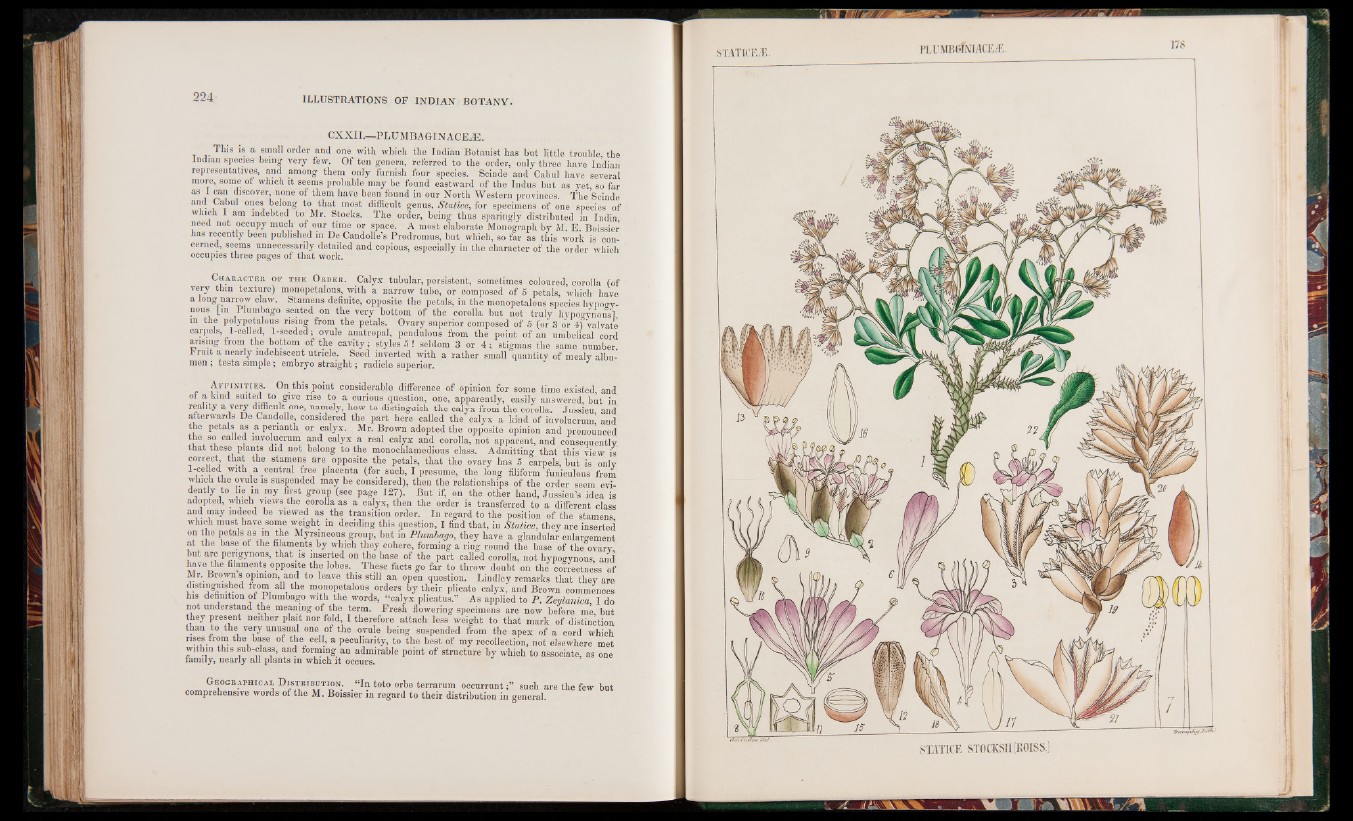
CXXII.—PLUMBAGINACEAE.
This is a small order and one with which the Indian Botanist has but little trouble the
Indian species being very few. Of ten genera, referred to the order, only three have Indian
representatives, and among them only furnish four species. Scinde and Cabul have several
more, some of which it seems probable may be found eastward of the Indus but as yet, so far
as I can discover, none of them have been found in our North Western provinces. The Scinde
and Cabul ones belong to that most difficult genus, Statice, for specimens of one species of
which I am indebted to Mr. Stocks. The order, being thus sparingly distributed in India
need not occupy much of our time or space. A most elaborate Monograph by M. E. Boissier
has recently been published in De Candolle’s Prodromus, but which, so far as this work is concerned,
seems unnecessarily detailed and copious, especially in the character of the order which
occupies three pages of that work.
Character of t h e O rder . Calyx tubular, persistent, sometimes coloured, corolla (of
very thm texture) monopetalous, with a narrow tube, or composed of o petals, which have
a long narrow claw. Stamens definite, opposite the petals, in the monopetalous species hypogv-
nous |m Plumbago seated on the very bottom of the corolla but not truly hypogynousl
in the polypetalous rising from the petals. Ovary superior composed of 5 (or 3 or 4) valvate
carpels, 1-celled, 1-seeded; ovule anatropal, pendulous from the point of an umbelical cord
arising from the bottom of the cavity ; styles 5 ! seldom 3 or 4 ; stigmas the same number,
b ruit a nearly indéhiscent utricle. Seed inverted with a rather small quantity of mealy albumen
; testa simple; embryo straight ; radicle superior.
Af f in it ie s . On this point considerable difference of opinion for some time existed, and
ot a kind suited to give rise to a curious question, one, apparently, easily answered, but in
reality a very difficult one, namely, how to distinguish the calyx from the corolla. Jussieu and
afterwards De Candolle, considered the part here called the calyx a kind of involucrum! and
the petals as a perianth or calyx. Mr. Brown adopted the opposite opinion and pronounced
the so called involucrum and calyx a real calyx and corolla, not apparent, and consequently
that these plants did not belong to the monochlamedious class. Admitting that this view is
correct, that the stamens are opposite the petals, that the ovary has 5 carpels, but is only
1-celled with a central free placenta (for such, I presume, the long filiform funiculous from
which the ovule is suspended may be considered), then the relationships of the order seem evi-
M m B I I I p y group (see page 127). But if, on the other hand, Jussieu’s idea is
adopted, which views the corolla as a calyx, then the order is transferred to a different class
and may indeed be viewed as the transition order. In regard to the position of the stamens
which must have some weight m deciding this question, I find that, in Statice, they are inserted
on the petals as in the Myrsineous group, but in Plumbago, they have a glandular enlargement
at the base of the filaments by which they cohere, forming a ring round the base of the ovary
but are perigynous, that is inserted on the base of the part called corolla, not hypogynous and
have the filaments opposite the lobes. These facts go far to throw doubt on the correctness of
Mr. Brown s opinion, and to leave this still an open question. Bindley remarks that they are
distinguished from all the monopetalous orders by their plicate calyx, and Brown commences
his definition of Plumbago with the words, “calyx plicatus.” As applied to P. Zeylanica I do
not understand the meaning of the term. Fresh flowering specimens are now before me but
they present neither plait nor fold, I therefore attach less weight to that mark of distinction
than to the very unusual one of the ovule being suspended from the apex of a cord which
rises from the base of the cell, a peculiarity, to the best of my recollection, not elsewhere met
within this sub-class, and forming an admirable point of structure by which to associate, as one
family, nearly all plants in which it occurs.
G eographical D istribution. “In toto orbe terrarum occurrunt;” such are the few b u t
comprehensive words of the M. Boissier in regard to their distribution in general.